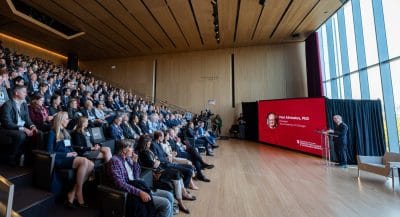The Institute for Climate and Sustainable Growth was proud to serve as the official academic thought partner for this year’s Aspen Ideas: Climate conference, which took place in Chicago on July 20-22, 2025.
The event, the first to be hosted in Chicago, brought together more than 1,300 leaders from business, government, philanthropy, academia, media, and the arts for dialogues aimed at bold, practical solutions to the climate and energy crisis. In collaborating with Aspen Ideas, the Institute added global expertise and cutting-edge research insights to the three-day conference, co-curating several sessions.
The Institute hosted the conference’s opening event at the David Rubenstein Forum on Sunday, July 20. The event featured a conversation with Alaska Governor Mike Dunleavy (R) and Michigan Governor Gretchen Whitmer (D) moderated by Institute Director Michael Greenstone. Greenstone, who also leads the Institute’s Energy Policy Institute at UChicago (EPIC), then participated in a panel discussion on markets on July 21. The directors of the Institute’s Climate Systems Engineering initiative, David Keith, and Energy Technologies Initiative, Shirley Meng, also participated in panels on carbon removal and energy technologies, respectively.
Several of the Institute’s advisors, fellows and friends also participated in the event. University of Chicago Trustee Michael Polsky, the CEO of Invenergy, spoke on investing in clean energy. EPIC advisory board member Jimmy Samartzis, CEO of Lanzajet, joined a panel on the future of flying. Former EPIC journalism fellows Robinson Meyer, Founding Executive Director of Heatmap News, and Justin Worland, climate reporter for TIME, moderated several panels. Meyer moderated the Keith and Samartzis panels and a session on the political landscape, while Worland moderated a discussion on the business case for climate action and building a modern grid. UChicago Institute of Politics Director and former Senator Heidi Heitkamp (D-ND) also participated in panels on carbon accounting and energy dominance.
Opening Panel: Finding Common Ground Between the Great Lakes and Arctic Shores
At the conference’s opening event, a panel with Governors Dunleavy and Whitmer explored how place, politics, and priorities have shaped different states’ approaches to energy, resilience, and economic development. The governors explored the balance between community needs and economic opportunity—and where surprising common ground might emerge.
Dunleavy championed Alaska’s role as an energy producer for the United States and the world, with natural reserves of “oil, gas, minerals, timber, rare earths,” and a proximity to Asia. Meanwhile, Whitmer stressed the human effects of climate change and the importance of bipartisan collaboration to get things done in a ‘purple’ state.
Greenstone asked the governors about their climate mitigation and adaptation strategies, while pointing out that Michigan and Alaska are two states that “on net, are likely to benefit from climate change.” Dunleavy stressed Alaska’s low carbon emissions and adaptability. Whitmer promoted Michigan’s “aggressive clean energy goals,” adding that “climate change hurts every one of us.”
“Even if you’re in a prime position on the globe, as some would look at the map and say Michigan is, we’re all paying a price for climate change,” she said, citing recent wildfire smoke affecting her state.
In Case of Emergency: Break Glass
On July 21, UChicago professor David Keith, who leads the Climate Systems Engineering initiative, joined a panel with Erin Burns, Executive Director of Climate180, and Zeke Hausfather, climate research lead for Stripe and a fellow at The Breakthrough Institute. The panel was moderated by Heatmap’s Robinson Meyer.
The panelists provided a look into the complex dynamics that surround the deployment of carbon dioxide removal (CDR) solutions and the latest science, policy, and scaling challenges that moderate its speed. Keith and his fellow panelists explained the careful balance between trade-offs and benefits of promising CDR methods—including direct air capture, ocean alkalinity enhancement and afforestation—as well as and how these fit into broader global strategies to mitigate the impacts of climate change. The three experts agreed on the importance of funding further research into these methods.
“I think in the near term, the goal is to learn,” said Keith, a professor in Geophysical Sciences. “The goal is to understand how well these things work, learn more about how they scale, because academic studies don’t tell us that, and learn about environmental impacts.”
The three panelists also stressed the importance of government support for CDR and expressed doubt in the effectiveness of market-based systems for CDR. Keith gave the example of sewage systems, a service that governments fund to similarly remove harmful waste.
“When we build sewer systems, we don’t have the poopers in one place and the sewer system providers in the other and impose a market and hope the market clears,” Keith said. “Ultimately, this is a public service that we need to pay for if we want to remove the CO2 from the atmosphere.”
The Return of the Market
The U.S. once led the way in using market tools to tackle environmental challenges, but in recent decades, these approaches gave way to tax breaks and subsidies seen as more politically palatable. Now, two major trends are reviving interest: developing countries need low-cost, high-impact solutions to cut emissions without stalling growth, and the world needs cutting-edge technologies to confront climate change.
On July 21, Institute Director Michael Greenstone joined a panel to explore these trends. The panel included Rama Variankaval, Global Head of Corporate Advisory at J.P. Morgan, Jane Flegal, Executive Director for the Blue Horizons Foundation, and Ali Zaidi, former White House National Climate Advisor. It was moderated by Juliet Eilperin, Deputy Futures Editor at The Washington Post.
Greenstone started off the panel by explaining how markets are very effective in reducing emissions at the least cost.
“Markets, in the textbook case, are really good at achieving whatever the environmental goal is but doing it at a low cost. One area where they have not been used that much is in developing countries, where the pollution problems are often the greatest,” said Greenstone, the Milton Friedman Distinguished Service Professor in Economics, citing the world’s first particulate pollution market in Gujarat, India.
Greenstone and his colleagues conducted a pilot experiment to test how well that market in Gujarat performed. He found: “First, firms greatly complied by the law, they didn’t comply before. Second, they greatly reduced their emissions. And third, they reduced the cost of compliance for firms,” he said. “I think it underscores that as the world has increasing ambitions for environmental policy and climate policy, it’s going to get more and more expensive to achieve those goals unless we really focus on the things that can do it at least cost.”
Zaidi brought in the “political economy questions,” which he thought were “unfortunately equal to the efficacy questions” because you need to consider that “we’re trying to solve for something that sticks.” Markets have politically been unpopular in the United States in recent years.
Throughout the panel, the speakers referred to the challenges created by many different policies among states and countries in the absence of global climate policy.
“A core problem of climate policy is that there’s no one setting global climate policy,” Greenstone said. “So then, as a consequence, in country A you have lots of policy, in country B you have none, and carbon emissions move there and what good was that in the end?”
Over the Horizon: Breakthroughs in Energy Technologies
Which breakthroughs are poised to transform the global energy system, and are there any that could disrupt our assumptions about technology, markets, and the future of energy?
On July 22, UChicago Professor Shirley Meng, Director of the Energy Technologies Initiative, joined Carl Hoiland, Chief Executive Officer at Zanskar, Jeff Navin, Co-Founder at Boundary Stone Partners, and Avra van der Zee, Chief Operating Officer at Elemental Excelerator, for a conversation to forecast the future of energy technology development. The panel was moderated by University of Texas-Austin Professor Michael Webber.
From breakthroughs in geothermal and energy storage to next-gen nuclear reactors, the panelists talked about the most promising energy technologies today—as well as the innovations that lie just over the horizon. Hoiland shared his transition from PhD to geothermal energy CEO; Navin recounted his experience establishing a new nuclear power plant in a Wyoming coal town; and Van der Zee gave her perspective as a clean energy investor. Meng shared her insights as a researcher, explaining the crucial role batteries play in the energy transition and laying out the future of battery technologies.
“In the future, you’re going to see more chemistries being used in batteries,” said Meng, a professor at the Pritzker School of Molecular Engineering. “I promise you, this year, if you come back to visit us again in the climate institute in UChicago, we will show you sodium batteries.”
She shared the benefits of such solid-state batteries, including safety and longevity. Meng also stressed the importance of “closed loop” battery production, framing batteries as an “asset” containing expensive materials to be recycled later.
A key theme of the panel was the importance of both incremental progress and breakthroughs in technological development. Though innovation can seem rapid, the panelists also stressed the decades of research, acquisition of funding, and fostering of international partnerships behind each breakthrough. The panelists also underscored the important roles that academia, government and industry each play in driving innovation, and that it is important that they all work together to achieve progress.























